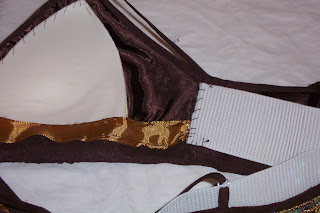Method 1:
If you can't sew and are desperate, take a short T-shirt that fits snugly and carefully tuck it up under your bra. Use another method if it looks lumpy or you will be dancing close to your audience (like a restaurant). Have a friend pin it in place.
Method 2 (minimal sewing):
1. Obtain a top that you like the look of, such as a black velvet (for a basic choli) or one in a color or pattern you like.
2. Put the top on, raise your arms high over your heed, have a friend mark 1" BELOW where the shirt hits your bra band under each arm.
3. Take the top off and lay it flat on a table or other surface you can mark or cut on.
4. Mark a straight line between the marks on each side.
5. Cut along the line CAREFULLY.
6. Try on the top to see where the new bottom hem falls.
7. Baste on pretty trim or ribbon - Heavier trim will help keep the hem "down" when you dance – this and some fringe can keep your performance “G” rated!
Method 3 (more sewing skill required):
1. Obtain a top that you like the look of, such as a black velvet (for a basic choli) or one in a color or pattern you like.
2. If you want to add any gathers to enhance the bustline, do it now (before proceeding to the steps below).
3. Put the top on, raise your arms high over your heed, have a friend mark 2.5" BELOW where the shirt hits your bra band under each arm.
4. Take the top off and lay it flat on a table or other surface you can mark or cut on.
5. Mark a straight line between the marks on each side.
6. Cut along the line CAREFULLY.
7. Try on the top to see where the new bottom hem falls. If it looks like you have enough fabric to add an elastic band, continue with the steps below; if not, go up to method #2, step 7.
8. Use a 3/4 inch to 1” band of elastic to make a bottom band, folding the fabric over to cover the band and sewing into place.
9. Wear with pride!
Any fabric that you cut off from the bottom of the “donor top” can still be used to make a sash or a belt.
Here are two versions; the black one on top uses method 2 (also adding trim to neck and cropped sleeves), while the bottom multicolored choli uses method 3.












